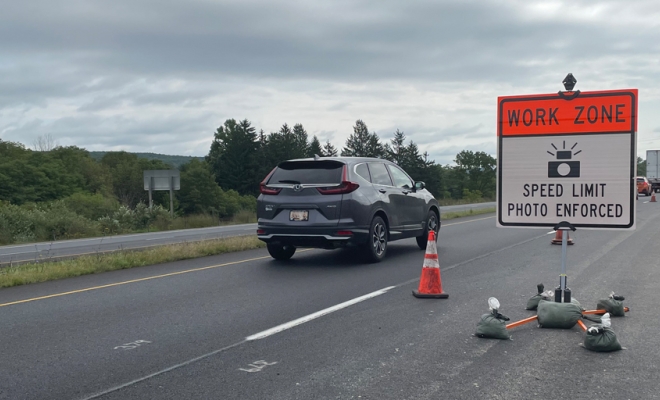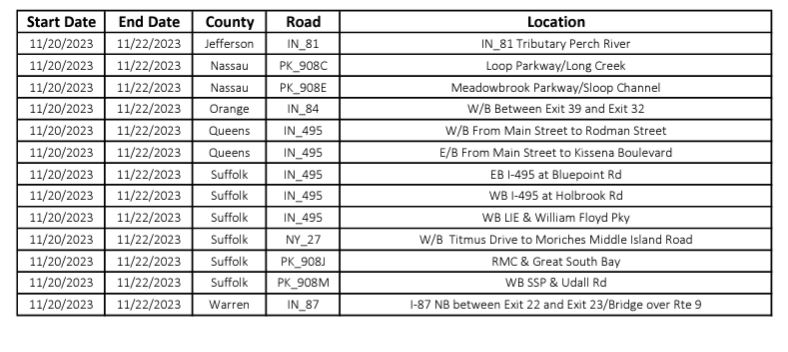Speed cameras are not new in New York State. In fact, residents of New York City are no stranger to the devices in active construction zones. Drivers can actually see where the radars will be set up by consulting the Work Zone Safety Awareness website.
However, for the rest of New York, the implementation comes as a surprise to some and an outrage to others.
The first rumblings of speed camera implementation on the Long Island Expressway (I-495) became apparent this past spring during heavy construction the highway was receiving. Such cameras were implemented in certain areas, but the lingering uncertainty of the State’s seriousness on cracking down on speeding at-large was also met with the intense fear of being ticketed at each work zone – of which there were dozens throughout Nassau and Suffolk counties.

The move came off the heels of the state legislature’s 2021 approval of the “Automated Work Zone Speed Monitoring” pilot program. This past April, drivers were given warning rather than speeding fines. Governor Kathy Hochul (D) said in an April statement regarding the legislation:
“This new pilot program will be instrumental in encouraging safe driving habits in highway work zones and protecting the lives of those who help maintain a safe and reliable highway system.”
According to state data, there were 441 work zone intrusions last year. A “work zone intrusion” is defined as an incident in which a vehicle has entered a roadway or portion of a roadway that is closed due to maintenance or construction. Such incidents resulted in three deaths and fifty-six injuries to construction workers and drivers.
As of November 20, thirteen locations across New York State were actively under radar technology surveillance, with the slated end date being November 22, just before the Thanksgiving holiday. Six of those locations were within Suffolk County: eastbound I-495 at Bluepoint Road, westbound I-495 at Holbrook Road, westbound I-495 at William Floyd Parkway, westbound Titmus Drive to Moriches Middle Island Road, Robert Moses Causeway and Great South Bay, and westbound Southern State Park and Udall Road.
Two Nassau County locations – Loop Parkway with Long Creek and Meadowbrook Parkway with Sloop Channel – as well as two locations in Queens, one in Warren County, one in Jefferson County, and one in Orange County were also included.
The radars detect vehicles traveling equal to or faster than the posted speed limit, with a grace window of ten miles per hour above the speed limit. This takes into account the varying speeds at which highway drivers tend to travel, allows room for passing or speeding up to match the speed of traffic when merging, or other occasional instances. The speeding triggers the system, which takes a series of photos displaying the vehicle’s speed and time of travel. According to the State, the cameras are not live, therefore do not constantly take photos of each vehicle that passes.
First-time violators will receive a $50 fine, followed by a $75 fine if the second violation occurs within eighteen months of the first one. Third and all subsequent violations will earn a $100 fine per violation within that same eighteen-month period. Fines are issued within fourteen business days. All fines can be paid online, by phone, or mail, and all fines can be disputed online.
According to the State, fines collected will cover expenditures related to the work zone safety program. If all expenditures are covered, excess revenues will be used for additional work zone safety initiatives.
Cameras are not unmarked and the State has insisted on visible signage present at each camera-enforced location.
The cameras, however, come with an interesting caveat: violations only produce fines, not points on a driver’s license. Points on a license tend to relay into increased insurance premiums. Since the Department of Transportation (DOT) is only scanning license plates to identify the car used to exceed the speed limit, rather the driver accelerating past the limit, points cannot be accrued on a driver’s license for their offenses, despite speeding being considered a moving violation that warrants both monetary fines and license points when filed by a police officer.
Furthermore, since vehicles are scanned, there can arise situations in which the alleged speeding vehicle is ambiguous if vehicles are clumped together or if multiple vehicles are traveling at similar speeds. As an apparent “check” on the system, DOT staff review speed camera violations and will reject violations unless they undoubtedly know which vehicle was speeding.









